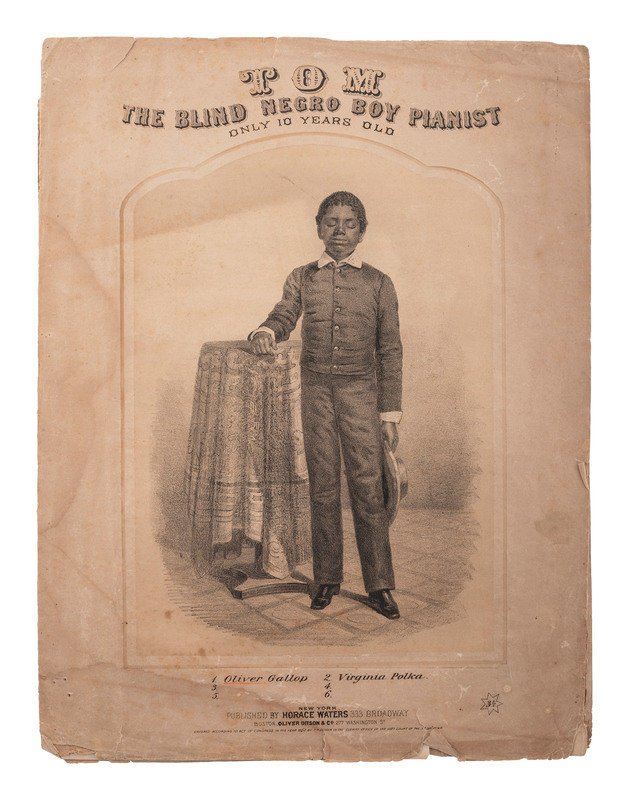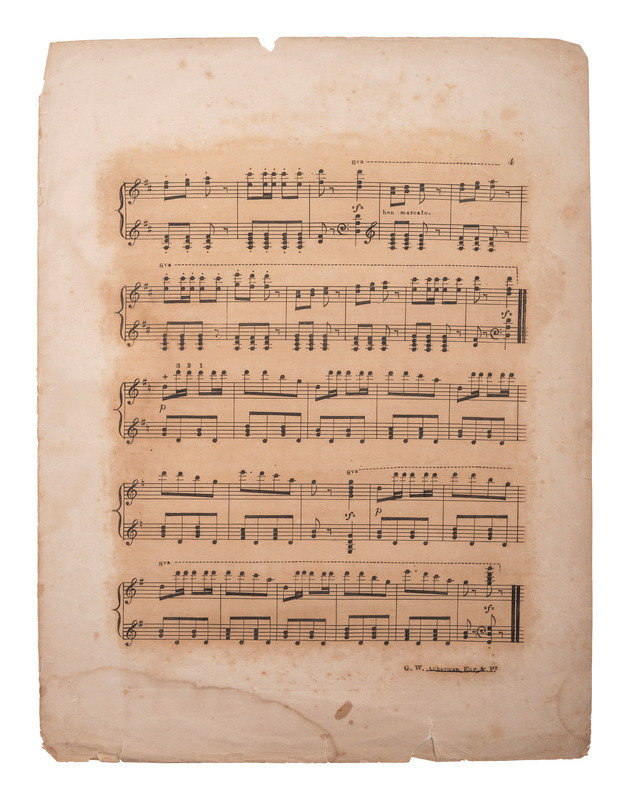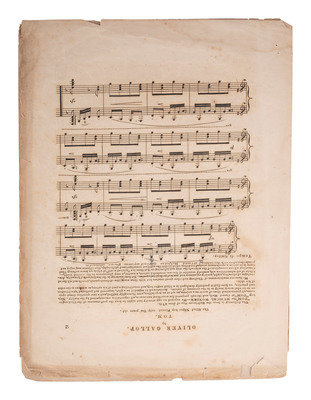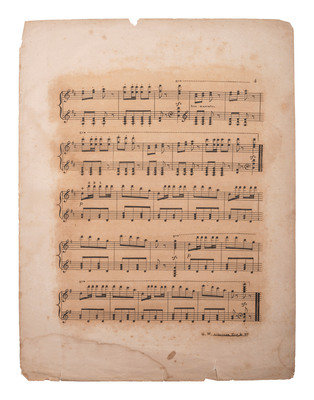Lot 279
[MUSIC] -- [WIGGINS, Thomas Greene "Blind Tom" (1849-1908)]. Tom, The Blind Negro Boy Pianist, Only 10 Years Old. New York: Horace Waters, 1860.
Sale 994 - African Americana
Feb 23, 2022
11:00AM ET
Live / Cincinnati
Own a similar item?
Estimate
$400 -
600
Price Realized
$344
Sold prices are inclusive of Buyer’s Premium
Lot Description
[MUSIC] -- [WIGGINS, Thomas Greene "Blind Tom" (1849-1908)]. Tom, The Blind Negro Boy Pianist, Only 10 Years Old. New York: Horace Waters, 1860.
4pp., 10 1/4 X 13 1/4 in. sheet music. Disbound and including music only for "Oliver Gallop" (toned, dampstain, chips to edges, hinge split).
Sheet music featuring a cover lithograph of the young musical prodigy known professionally as "Blind Tom" and his song "Oliver Gallop."
The story of Thomas “Blind Tom” Wiggins (1849-1908) is one of beauty and tragedy intertwined. He is described by many today as an autistic savant and was presumed to be mentally deficient in his lifetime, described by many contemporaries as nothing more than a human parrot. Such discussions often overshadow his artistic achievement. He demonstrated a preternatural skill in playing the piano, was able to memorize long passages both music and speech and possessed an uncanny ability to recreate almost any sound he heard. Belying his supposed “idiocy,” he wrote and published music and continuously toured throughout the United States, including the western frontier, as well as internationally most of his life.
Born into enslavement in Georgia, he was purchased as a young child with his parents by General James Neil Bethune (1803-1895). Blind at birth, Tom’s musical talent was recognized early and Bethune leased Tom to a Barnum-style spectacle producer at the tender age of 8. He performed as often as four times a day earning his enslaver over $100,000 a year. In 1860, he visited Congress and played for President James Buchanan, possibly the first featured performance by an African American at the White House. He almost certainly earned more than any other pianist of the day, though it is the tragic reality that his earnings went to neither him nor his family. Despite the outcome of the Civil War, Tom by any practical measure never seems to have gained his own freedom. Declared non compos mentis, General Bethune applied for Tom’s guardianship and continued to exploit his labor. In 1875, Bethune transferred management of Tom to his son John. After John’s death, Tom was at the center of a fierce custody battle. In the proceedings, he is often written about as though he was property, rather than a person. Even in 1895, when Bethune was on his deathbed, the New York Times headline read, “The Owner of ‘Blind Tom’ Ill.”
Musically, he is best remembered for composing The Battle of Manassas (1861 or 1862) which poignantly represents the complicated life of Blind Tom. The piece memorializes the First Battle of Bull Run (known by Confederates as the First Battle of Manassas), the first major battle of the Civil War, and a decisive victory for the South. It was met with critical acclaim by white audiences and newspapers and possibly used to raise money for the Confederate cause. Black voices are silent, with African American newspapers having distanced themselves from Tom, believing that white slaveowners used Tom to perpetuate stereotypes and line their own pockets. The piece itself, described as a tone poem, demonstrates Tom’s remarkable capability of capturing the atmosphere of a scene, recreating the sounds of the battlefield. Notably, it is one of the first examples of tone clusters, used to represent cannon fire. The piece was played continuously at nearly every concert until his death in 1908.
The story of Thomas “Blind Tom” Wiggins (1849-1908) is one of beauty and tragedy intertwined. He is described by many today as an autistic savant and was presumed to be mentally deficient in his lifetime, described by many contemporaries as nothing more than a human parrot. Such discussions often overshadow his artistic achievement. He demonstrated a preternatural skill in playing the piano, was able to memorize long passages both music and speech and possessed an uncanny ability to recreate almost any sound he heard. Belying his supposed “idiocy,” he wrote and published music and continuously toured throughout the United States, including the western frontier, as well as internationally most of his life.
Born into enslavement in Georgia, he was purchased as a young child with his parents by General James Neil Bethune (1803-1895). Blind at birth, Tom’s musical talent was recognized early and Bethune leased Tom to a Barnum-style spectacle producer at the tender age of 8. He performed as often as four times a day earning his enslaver over $100,000 a year. In 1860, he visited Congress and played for President James Buchanan, possibly the first featured performance by an African American at the White House. He almost certainly earned more than any other pianist of the day, though it is the tragic reality that his earnings went to neither him nor his family. Despite the outcome of the Civil War, Tom by any practical measure never seems to have gained his own freedom. Declared non compos mentis, General Bethune applied for Tom’s guardianship and continued to exploit his labor. In 1875, Bethune transferred management of Tom to his son John. After John’s death, Tom was at the center of a fierce custody battle. In the proceedings, he is often written about as though he was property, rather than a person. Even in 1895, when Bethune was on his deathbed, the New York Times headline read, “The Owner of ‘Blind Tom’ Ill.”
Musically, he is best remembered for composing The Battle of Manassas (1861 or 1862) which poignantly represents the complicated life of Blind Tom. The piece memorializes the First Battle of Bull Run (known by Confederates as the First Battle of Manassas), the first major battle of the Civil War, and a decisive victory for the South. It was met with critical acclaim by white audiences and newspapers and possibly used to raise money for the Confederate cause. Black voices are silent, with African American newspapers having distanced themselves from Tom, believing that white slaveowners used Tom to perpetuate stereotypes and line their own pockets. The piece itself, described as a tone poem, demonstrates Tom’s remarkable capability of capturing the atmosphere of a scene, recreating the sounds of the battlefield. Notably, it is one of the first examples of tone clusters, used to represent cannon fire. The piece was played continuously at nearly every concert until his death in 1908.
Condition Report
Contact Information
Auction Specialist





